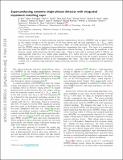Superconducting nanowire single-photon detector with integrated impedance-matching taper
Author(s)
Zhu, Di; Colangelo, Marco; Korzh, Boris A.; Zhao, Qingyuan; Frasca, Simone; Dane, Andrew Edward; Velasco, Angel E.; Beyer, Andrew D.; Allmaras, Jason P.; Ramirez, Edward; Strickland, William J.; Santavicca, Daniel F.; Shaw, Matthew D.; Berggren, Karl K.; ... Show more Show less
DownloadSubmitted version (2.042Mb)
Terms of use
Metadata
Show full item recordAbstract
Conventional readout of a superconducting nanowire single-photon detector (SNSPD) sets an upper bound on the output voltage to be the product of the bias current and the load impedance, I B × Z load , where Z load is limited to 50 Ω in standard r.f. electronics. Here, we break this limit by interfacing the 50 Ω load and the SNSPD using an integrated superconducting transmission line taper. The taper is a transformer that effectively loads the SNSPD with high impedance without latching. At the expense of reduced maximum counting rate, it increases the amplitude of the detector output while preserving the fast rising edge. Using a taper with a starting width of 500 nm, we experimentally observed a 3.6× higher pulse amplitude, 3.7× faster slew rate, and 25.1 ps smaller timing jitter. The results match our numerical simulation, which incorporates both the hotspot dynamics in the SNSPD and the distributed nature in the transmission line taper. The taper studied here may become a useful tool to interface high-impedance superconducting nanowire devices to conventional low-impedance circuits.
Date issued
2019-01Department
Massachusetts Institute of Technology. Research Laboratory of Electronics; Massachusetts Institute of Technology. Department of Electrical Engineering and Computer ScienceJournal
Applied Physics Letters
Publisher
American Institute of Physics (AIP)
Citation
Zhu, Di et al. "Superconducting nanowire single-photon detector with integrated impedance-matching taper." Applied Physics Letters 114 (January 2019): 22901 © 2019 Author(s)
Version: Original manuscript
ISSN
0003-6951
1077-3118